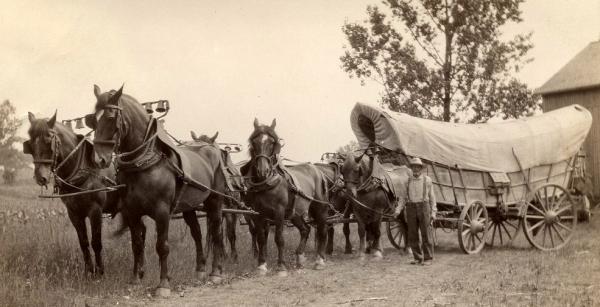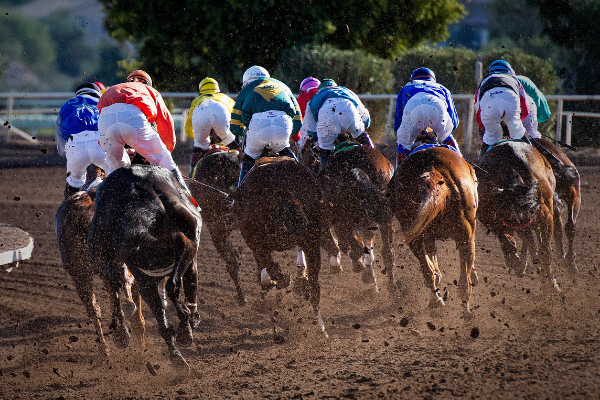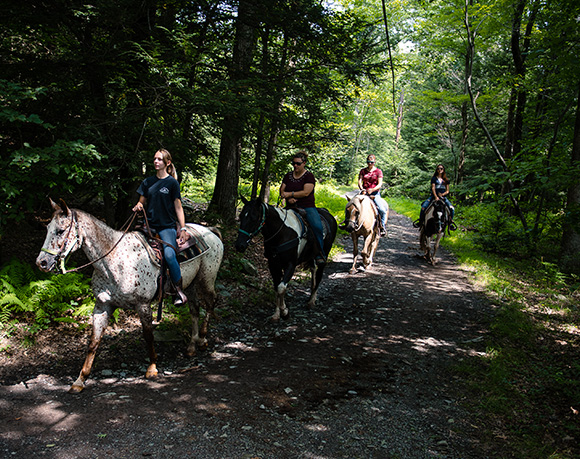14 Oct The History of Horses in the Greater Philadelphia Area
Horse History, Summed Up
Contrary to popular belief, horses originated millennia ago in what is now North America. These horses are suspected to have migrated to Europe via the Bering Land Bridge. They roamed throughout North America until about 8,000 – 10,000 years ago, when they went extinct from unknown causes.
It was not until 1493 that Iberian horses arrived back on North American soil with the Spanish fleet. Some of these horses escaped and became feral (leading to repopulation in the Midwest), and eventually some of them were traded by the Spanish to Native Americans, becoming an essential mode of transport for tribes across the Great Plains and Midwest.
Horses Return to North America and Shape Early Settlement
This reintroduction led to the normalization of horses, though since they are expensive to maintain and require a great deal of land, they were often relegated to the elites of the day. As European settlements expanded, horses symbolized status, wealth, and power.
Further settlement by Europeans brought additional breeds that were, again, used by the wealthy to pull carriages and for leisure riding and sport. As the burgeoning U.S. expanded and the cities of the East Coast became better connected with roads, trade increased.
While oxen were the traditional draft animals, their sturdy but slow pace clashed with increased trade demands. Wealthy merchants began using horses to transport their products faster, leading to the gradual replacement of oxen with horses.
The Conestoga Draft Horse: Pennsylvania’s First Powerhouse Breed
What do the Conestoga River, covered wagons, and driving on the right side of the road have in common? The Conestoga draft horse!
Conestoga draft horses were used to pull Conestoga wagons (surprising, right?) — both of which were named after the area in which they were developed: Conestoga Township in Lancaster County, Pennsylvania, not far from Philadelphia. This area is still considered “horse country,” known for its deep Amish roots and its continued reliance on horses for farming and transportation.
In fact, the area is home to some of the largest horse auctions in the nation, with thousands of horses going through Mel’s Stable and New Holland Sales Stables every year.
Returning to the past for a moment, Conestoga wagons were large, heavy wagons that served as transport for bulk goods along the Northeast coast of the United States between 1700 and 1890. These wagons required a team of six powerful horses, and because of their massive weight, the Pennsylvania Dutch developed the Conestoga draft horse specifically to handle the job.
As seen in the picture below, the Conestoga wagon had no seat for the driver; rather, he would sit on the back of the left-most horse in the team, allowing him to steer with his dominant right hand. This led to wagons keeping to the right side of the road, a custom that influenced America’s modern right-hand driving tradition.
This setup later inspired Henry Ford to place the steering wheel on the left side of his Model T, mirroring the way wagon drivers once rode.
Credit: Courtesy of the Landis Valley Farm Museum
Interestingly, the Conestoga horse was the first recorded horse breed developed in the United States. These horses played a major role in the function and expansion of the city of Philadelphia, serving as an early engine of American commerce and trade.
War Horses and Iron Horses
This all changed with the beginning of the American Civil War in 1861. Horses in both the North and the South were repurposed for war, and while a large portion of the Southern soldiers used their own horses for the cavalry, the northern soldiers rode whatever horses were available. This led to widespread abuse, as horses are pack animals and do not fare well when the bonds they form with their herd are severed. By the war’s end in 1865, horse casualties were estimated to be twice those of human soldiers.
Decades earlier, railroads were beginning to reshape America. Thirty years before the Civil War, the Baltimore and Ohio Company laid the first operational railroad lines. These lines, based on English designs, allowed horses to pull heavy granite carts with less friction than traditional wheels.
Horses were instrumental in building the railways themselves, pulling carts of supplies and materials. However, as the U.S. expanded westward, maintaining horse transport over long distances became impractical.
Then, with the massive equine casualties caused by the Civil War, horses became even more scarce and expensive. This scarcity led B&O executives to commission inventor Peter Cooper to design a steam engine capable of replacing horses entirely.
He succeeded, and thus began the age of the “iron horse.” Horses were gradually relegated to shorter hauls, agriculture, and local transport. With the rise of the motorized carriage (the car), horses lost their central role in American transportation—but not their cultural importance.
A New Purpose for Horses: Entertainment and Leisure
Horse Racing in Pennsylvania and the Philadelphia Area
The coincidence of war and industrialization rendered the horse both more expensive and less necessary in daily life—particularly in the Northeast. This shift led horses to find a new role in entertainment and sport.
Horse racing, though established earlier (the first racetrack opened in Long Island in 1665), boomed in the 1870s. The first Kentucky Derby was run in 1875 at the Louisville Jockey Club Course (now Churchill Downs), and the sport grew in popularity through both World Wars.
Pennsylvania’s strict gambling laws, however, delayed the rise of local racetracks. The first, The Meadows Racetrack and Casino, did not open until 1963. Today, Pennsylvania has six horse racing tracks—the newest being Presque Isle Downs, which opened in 2007.
The greater Philadelphia area features two major racetracks and casinos: Parx Racing at Parx Casino and Harrah’s Philadelphia Casino and Racetrack.
Fun Fact: Most jockeys were African American until segregation in the 1950s reshaped the sport.
Horseback Riding Lessons and Guided Trail Rides Near Philadelphia
Lesson barns cater to those who want to develop their horse-sense and riding skills. This could be for equestrian sports such as polo or barrel racing, or simply to prepare for owning a horse. Lesson barns typically offer comprehensive training on grooming, saddling, horse care, and English-style riding.
Pennsylvania and northern New Jersey are full of reputable lesson barns, some even offering horse boarding.
In contrast, hack stables focus on guided trail rides using Western tack, providing a fun, beginner-friendly experience. Hack horses are trained to follow the lead guide with minimal input from riders, making them perfect for newcomers.
Mountain Creek Riding Stable, located in the Pocono Mountains about two hours from Philadelphia, offers a variety of horseback experiences—from scenic trail rides to pony rides for children and wagon rides for groups.
Tip: Curious about the difference between English and Western riding? Check out our other blog, English vs. Western Horseback Riding Styles, for a deep dive into tack, skills, and techniques. And for those just beginning their horseback riding experience, here’s a guide to horse riding for beginners! Though less prevalent than lesson barns, hack stables can still be found dotted around the Philly area and northern New Jersey (that’s what we here at Mountain Creek are, btw!)
The Modern Philly Horse: Preserving Urban Equestrian Culture
Being such a densely populated urban area, there are few horses in modern Philadelphia. The exception is the Fletcher Street Urban Riding Club, a nonprofit founded in the 1980s by Ellis Ferrell.
The club introduces urban youth to horseback riding, teaching responsibility, confidence, and care for animals through hands-on experience.
Unfortunately, if you live in Philly and want to enjoy horseback riding, you’ll likely need to leave the city proper. Just a short drive away, Mountain Creek Riding Stable offers guided rides through the Pocono Mountains—perfect for beginners, families, and anyone craving time with horses.
Experience Pennsylvania’s Living Horse History
From Lancaster’s legendary Conestoga horses to Philadelphia’s modern riding clubs, the state’s horse history is alive and well.
Experience it for yourself with a guided trail ride in the Poconos at Mountain Creek Riding Stable, where history meets adventure in the heart of the Pocono Mountains.
Where can I go horseback riding near Philadelphia?
Mountain Creek Riding Stable in the Poconos offers guided horseback rides, pony rides, and wagon rides about two hours from Philly.
What is the Conestoga horse?
The Conestoga draft horse was America’s first recorded breed, developed in Lancaster County, PA, to pull the heavy Conestoga wagons used along colonial trade routes.
Are there still horses in Philadelphia?
Yes, though rare. The Fletcher Street Urban Riding Club continues the city’s equestrian tradition by offering urban youth access to horses and riding programs.
What horse racing tracks are near Philadelphia?
Parx Racing in Bensalem and Harrah’s Philadelphia Casino and Racetrack in Chester are two major options for horse racing fans.






No Comments